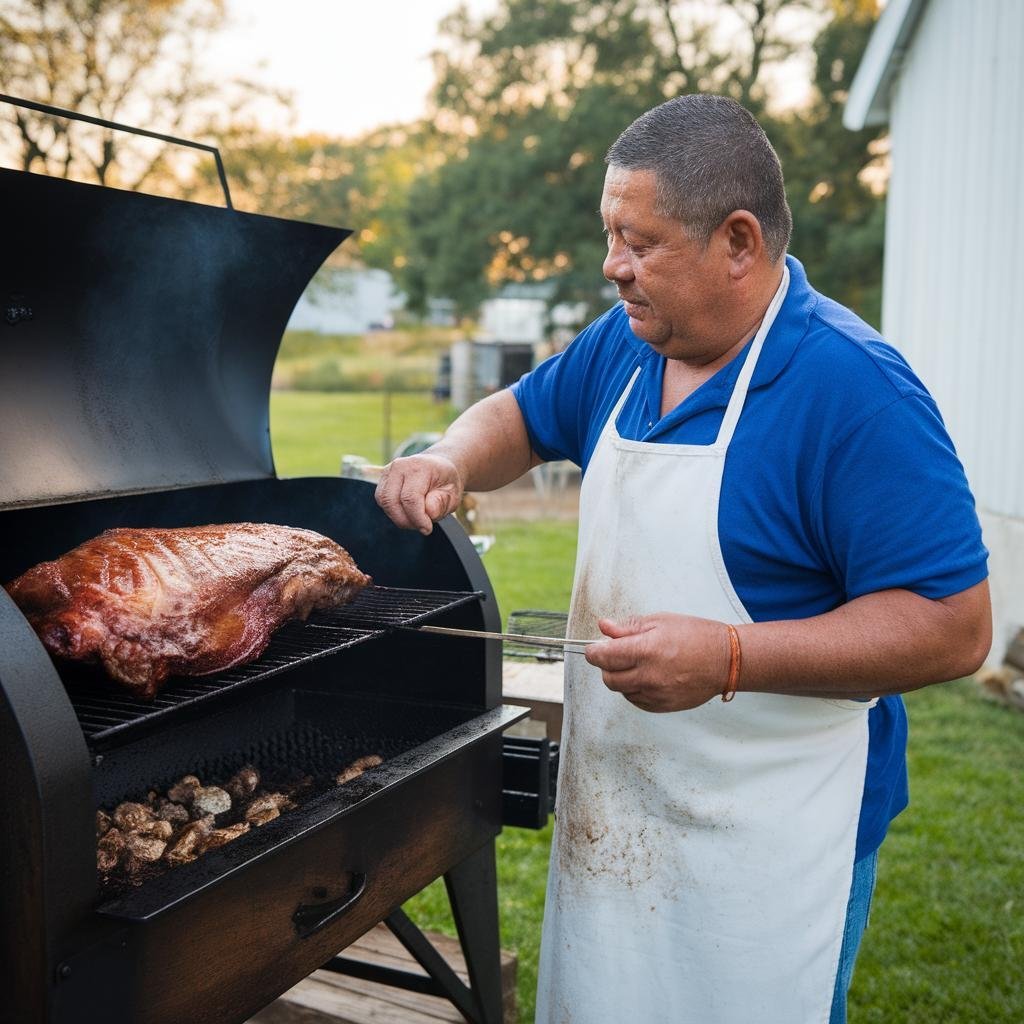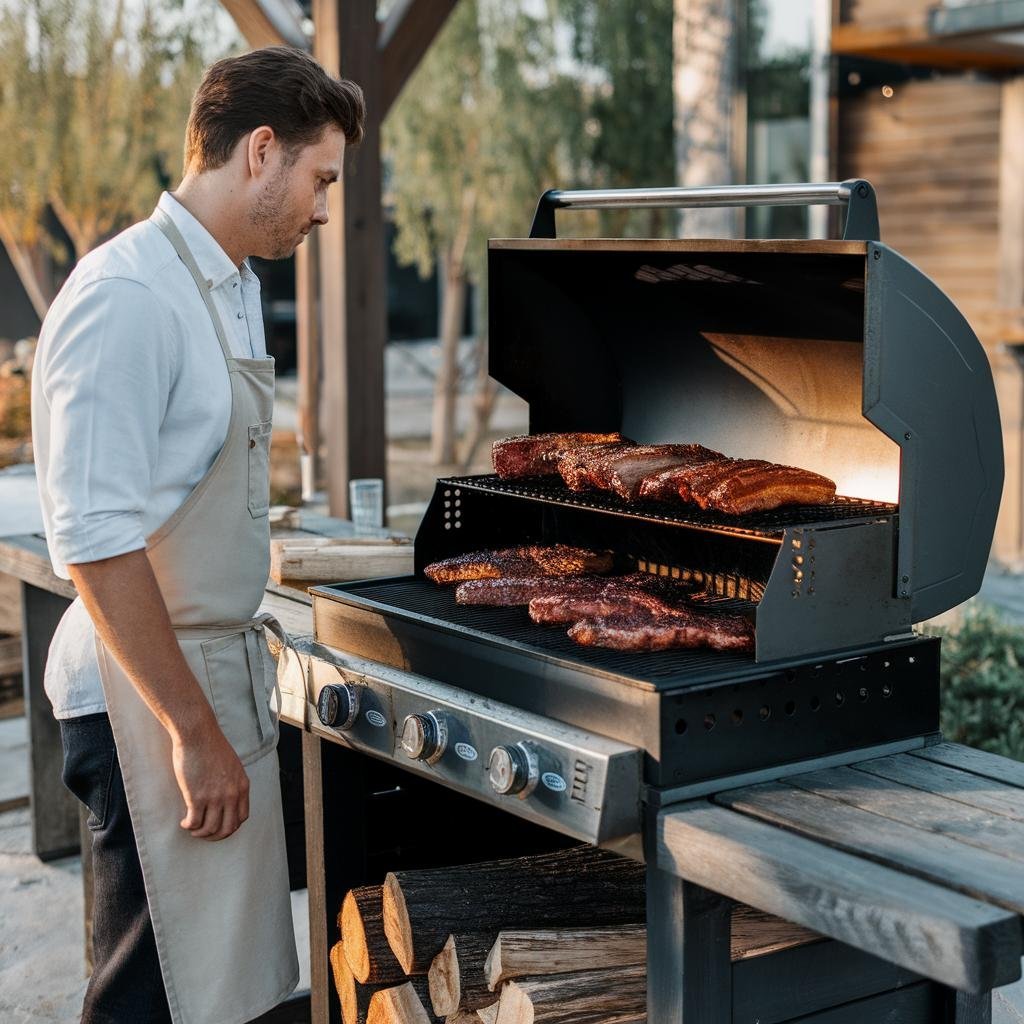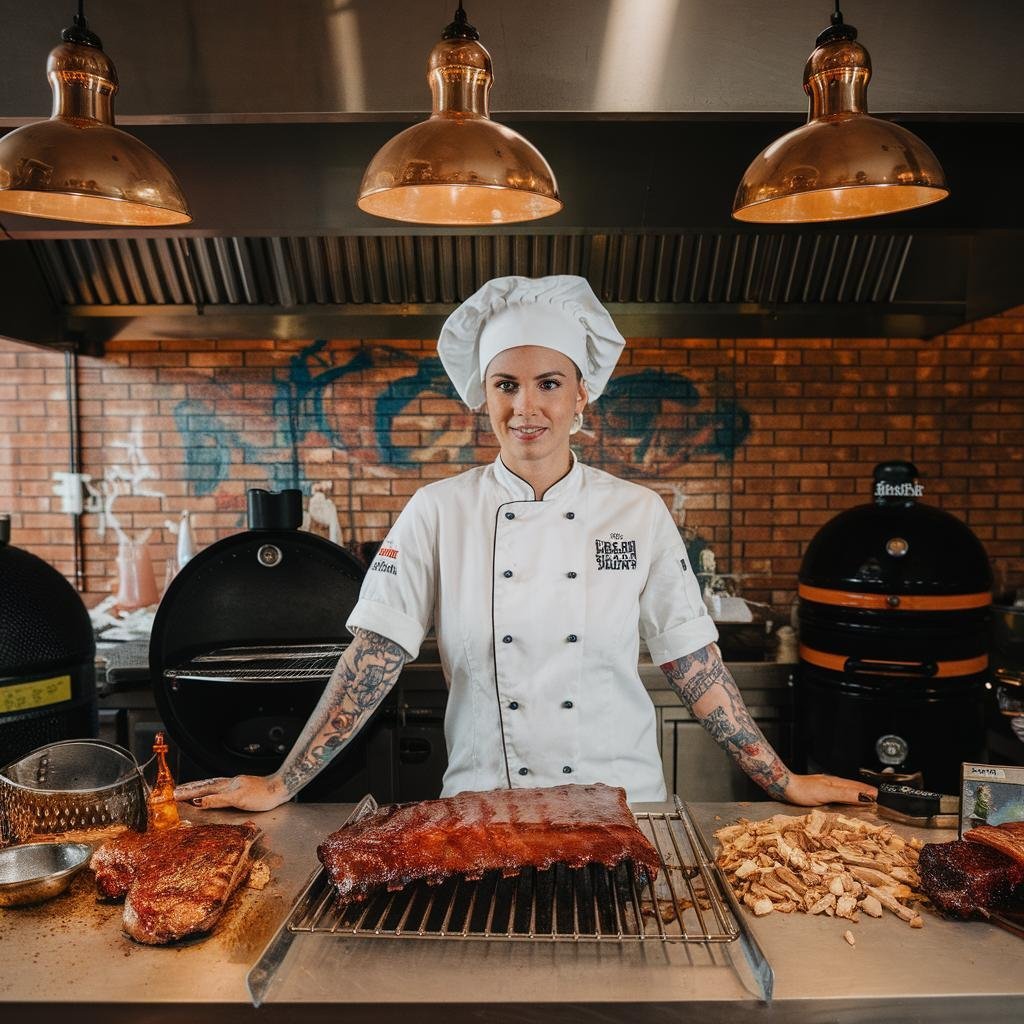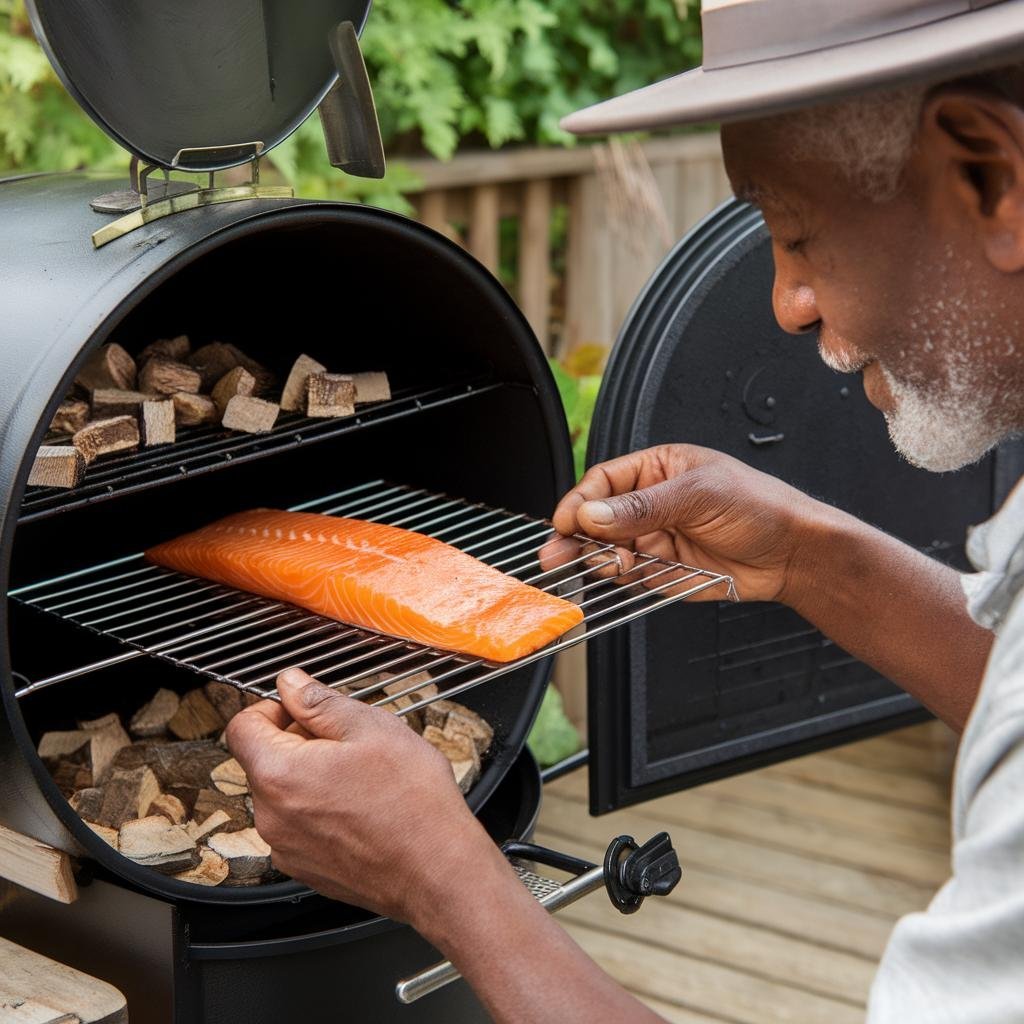Disclosure: This Post Contains Affiliate Links; We earn a commission on purchases.
Are you a barbecue enthusiast looking to take your grilling skills to the next level? Understanding the science behind smoking can help you achieve the perfect balance of heat, smoke, and flavor in your barbecue. Smoking involves more than just cooking with wood; it’s a fascinating blend of chemistry, physics, and culinary artistry.
When we burn wood, tiny, unburnt particles are released, creating smoke. The volatile organic compounds in wood break down and turn into smoke, which imparts that unmistakable flavor to our food. The most important components of wood smoke are syringol and guaiacol, which give the smoky taste we all crave.
As meat absorbs smoke, various chemical processes occur. Proteins fuse and explode, creating a deliciously crusty bark on the surface of the meat. The interaction between nitric oxide and iron in the meat forms a pink smoke ring, a prized feature for barbecue enthusiasts.
So, how do you maximize smoke flavor? Wetting the meat or using a rub can enhance smoke absorption, while the smoke mainly flavors the surface of the meat. Contrary to popular belief, meat continues to take on smoke throughout the cooking process, resulting in a smokier flavor.
Now that you understand the basics, let’s delve deeper into the science of smoke, the components that contribute to its flavor, and the techniques and wood choices that can help you create the most delectable barbecue dishes.
Key Takeaways:
- Smoke is a combination of tiny, unburnt particles released when we burn wood, creating that distinct smoky flavor.
- Proper moisture content in the wood and good airflow are crucial for generating thin, blue smoke.
- Different types of wood have varying flavor profiles due to the proportions of cellulose, hemicellulose, and lignin.
- Wetting the meat or using a rub can enhance smoke absorption and flavor penetration.
- Smoke rings are formed when nitric oxide gas produced during combustion reacts with myoglobin in the meat, creating a pink pigment.
The Flavor of Smoke: Understanding the Components of Wood Smoke
The flavor of smoke in barbecue is a fascinating result of burning wood and the unique composition of wood smoke. When wood is burned, it releases various gases and particles that contribute to the flavor profile of smoke.
Wood smoke contains solid particles of soot and droplets of liquid suspended in air and chemicals. These visible particles give smoke its hazy appearance. The vapors of air and chemicals carrying these particles are responsible for the flavor of smoke.
Different types of wood have varying proportions of cellulose, hemicellulose, and lignin, which are organic compounds present in wood. When wood is burned, these compounds break down and produce distinct flavors.
Cellulose and hemicellulose break down into sweet flavors such as peach, coconut, and green apple. These flavors penetrate the outer layers of meat and add a delightful sweetness to the overall taste.
Lignin, on the other hand, creates pungent and spicy phenolic flavors. These flavors add unique depth and complexity to the smoked meat and contribute to its characteristic smoky aroma.
Additionally, during the combustion process, nitric oxide gas is produced and diffuses into the meat. This gas reacts with myoglobin, a protein responsible for the pink color in meat, creating a stable pink pigment known as the smoke ring.
This smoke ring not only adds visual appeal but also enhances the overall flavor of the meat. It is also responsible for the pink color commonly seen in cured meats like bacon.
The combination of these flavor compounds and the presence of the smoke ring results in the distinctive taste and appearance that is often associated with smoked meat.
Generating Smoke: Techniques and Wood Choices
Smoke generation in the realm of barbecue is a delicate art that requires a combination of techniques and careful selection of wood. Different techniques and wood choices can significantly impact the flavors and aromas infused into the grilled delicacies. Let’s explore the various methods and wood options that can elevate your smoking game.
Techniques for Smoking
When it comes to generating smoke for grilling, several techniques have proven effective. Using logs, wood chunks, wood chips, or pellets are popular methods employed by pitmasters and grill enthusiasts alike.
- Logs: Logs are best used in offset smokers or pit BBQs, where they can provide a steady and prolonged supply of smoke.
- Wood chunks: Wood chunks are ideal for charcoal smokers or for adding an extra smoky flavor to the grill.
- Wood chips: Wood chips, smaller than chunks, can be used with charcoal or gas grills to infuse a delightful smoky essence into the food.
- Pellets: Finely ground hardwood pellets are commonly used in smoke boxes and regular smokers, ensuring a consistent and controlled smoke output.
Types of Wood for Smoking
The choice of wood plays a crucial role in determining the flavors imparted to the grilled creations. Different types of wood yield distinctive taste profiles, allowing for endless experimentation and culinary exploration.
Hardwoods like hickory and mesquite are renowned for their robust flavors that can harmonize with a wide range of meats. Fruitwoods like apple and cherry offer a subtler and slightly sweet smoke that enhances the natural flavors of poultry, pork, and fish.
However, it’s important to steer clear of softwoods when smoking, as they can produce unwanted flavors that may overpower the delicate nuances of the food.
Smoke Generation Methods
The process of smoke generation begins when wood is exposed to heat. As the wood heats up, the bonds between its carbon, hydrogen, and oxygen atoms break down, resulting in the release of energy and the formation of a hot gas. Initially, the wood dries out, releasing steam, and once dry, it begins to break down and produce smoke, which carries the desirable flavor compounds.
For optimal flavor release, it is essential to achieve the ideal combustion temperature range of 300°C to 400°C. This temperature range ensures the emission of a clean smoke, free from excessive carbon or soot.
The skill of the pit master lies in controlling airflow, moisture content, and combustion temperature, as these factors greatly impact the quality of smoke produced. Achieving the right moisture content in the wood is vital, as overly wet or dry wood can affect the overall smoking experience.
| Wood Type | Flavor Profile |
|---|---|
| Hickory | Strong and smoky |
| Mesquite | Robust and intense |
| Apple | Subtle and slightly sweet |
| Cherry | Delicate with a hint of sweetness |
Understanding the techniques for smoke generation and the nuances of different wood choices empowers barbecue enthusiasts to experiment and craft their signature flavors. Whether you prefer the boldness of hickory or the delicacy of cherry wood, the world of smoke flavor awaits your exploration.
The Art of Smoking: Maximizing Smoke Flavor in Barbecue
When it comes to barbecue, maximizing smoke flavor is an art that requires attention to certain techniques. By implementing these tips for smoking, you can enhance the flavor of your barbecue and create a memorable dining experience.
One technique for enhancing smoke flavor is wetting the meat before smoking. By moistening the surface of the meat, you create a surface that attracts and traps smoke, allowing for better flavor penetration. This technique is particularly effective for larger cuts of meat, such as brisket or pork shoulder.
Another way to enhance smoke flavor is by using a rub. A rub is a blend of spices and herbs that can add layers of flavor to the meat. When applying the rub, make sure to thoroughly coat the meat, ensuring that every bite is bursting with flavor.
Tip: Experiment with different rub combinations to discover your favorite flavor profiles. From smoky and savory to sweet and tangy, the possibilities are endless!
During the cooking process, lightly spritzing or basting the meat can also increase smoke absorption. As the meat cooks, particles naturally move from warmer to cooler surfaces. This process, known as thermophoresis, causes smoke to be attracted to the cooler surface of the meat, further enhancing the smoke flavor.
It is a common misconception that meat stops taking on smoke after a certain amount of time. While the meat may absorb less smoke as it cooks, longer smoking times actually result in smokier flavors. For a truly intense smoke flavor, consider adding more wood during the cooking process to continuously impart smoke and flavor to the meat.
Tip: Start with a small amount of wood, around two to three ounces, and gradually add more wood to achieve the desired level of smoke flavor. Remember, too much smoke can lead to a bitter taste, so it’s important to find the right balance.
Airflow, humidity, and personal preferences can also impact the amount of smoke needed to achieve optimum results. Pay attention to these factors and adjust accordingly to maximize the smoke flavor in your barbecue.
Tip: Consider using different types of wood to experiment with different flavor profiles. Hardwoods like hickory and mesquite are popular choices due to their rich and robust flavors, while fruitwoods like apple and cherry provide a slightly milder and sweeter smoke.
By mastering the art of smoking and incorporating these tips for maximizing smoke flavor, you can elevate your barbecue to new heights. Whether you’re a seasoned pitmaster or a backyard enthusiast, the enhanced smoke flavor will leave everyone craving more.
The Science Behind Smoke Rings in Barbecue
Smoke rings in barbecue are an intriguing phenomenon with a scientific explanation. When wood burns, a small amount of nitric oxide gas is produced. As this gas hits the surface of the meat, it diffuses into the meat and reacts with myoglobin, a protein responsible for the pink color in meat. This reaction forms a stable pink pigment, creating the smoke ring. The smoke ring is visible at a depth of 8mm-10mm below the meat’s surface.
The same compound is responsible for the pink color in cured meats like bacon, where it is formed through the reaction of curing salts with myoglobin. Many barbecue chefs consider a deep and obvious smoke ring as a trophy, indicating skill and expertise.
To achieve a good smoke ring, keeping the meat’s surface moist through the use of a mop sauce can be helpful. However, in competitive barbecue, the authenticity of the smoke ring is sometimes questioned, as it can be artificially created by dusting the meat with nitrate-based curing salt. Despite the debate in competition, a smoke ring adds a visually appealing element to smoked meat and enhances the overall barbecue experience.
| Smoke Ring Factors | Importance | Tips |
|---|---|---|
| Gas Release | Crucial | – Ensure proper wood combustion – Maintain ideal temperature range – Achieve clean smoke |
| Meat Surface | Important | – Keep moist with mop sauce – Spritz or baste meat to attract smoke |
| Nitrate-Based Salt | Controversial | – Authenticity debated – Use with caution, if desired |
Choosing the Right Wood for Smoking
Selecting the right wood for smoking is crucial in achieving the desired flavors in barbecue. Different types of wood offer a variety of flavors, making it important to choose the best wood to enhance your BBQ experience. Hardwoods are preferred for smoking due to their slower-burning and less intense characteristics. Let’s explore some popular choices and their unique attributes:
Oak
One of the most popular hardwoods, oak provides a mellow smoke that adds flavor without overpowering the meat. It burns steadily, allowing for better heat control during the smoking process.
Mesquite
If you’re looking for a strong and smoky flavor, mesquite is an excellent choice. Its bold flavor is often favored by those who enjoy a more powerful smoky taste in their barbecue.
Fruitwoods (Apple and Cherry)
Fruitwoods like apple and cherry produce medium levels of smoke, offering a balanced combination of flavors. These woods add a touch of sweetness to the meat and complement a variety of dishes.
Maple and Alder
For meats that can be easily overpowered by stronger smoke, milder smoky flavors from maple and alder are ideal. These woods provide a subtle smokiness that enhances the natural flavors of the meat.
It’s important to avoid softwoods for smoking, as they can produce undesirable flavors. Additionally, using dry wood is crucial for achieving optimal smoke quality. The size and shape of wood pieces, such as logs, chunks, chips, or pellets, also play a role in controlling the intensity and duration of smoke.
By carefully selecting the right wood for smoking, you can enhance the flavors of your barbecue and create a memorable dining experience.
| Wood | Flavor Profile |
|---|---|
| Oak | Mellow, balanced |
| Mesquite | Strong, smoky |
| Apple | Medium, sweet |
| Cherry | Medium, fruity |
| Maple | Mild, subtle |
| Alder | Mild, delicate |
Conclusion
Smoking techniques combine the science of heat, smoke, and flavor to create a unique and delicious barbecue experience. When wood is burned, volatile organic compounds are released, infusing the food with a distinct smoky taste. The interaction between proteins, sugars, and the smoke creates flavor profiles like a flavorful crusty bark and the coveted pink smoke rings that add visual appeal to the meat.
Enhancing smoke absorption and flavor penetration can be achieved through various smoking techniques. Wetting the meat, using rubs with spices and herbs, and spritzing or basting during the cooking process can intensify the smoky flavors. However, the choice of wood is crucial in achieving the desired taste. Hardwoods such as hickory and mesquite offer robust flavors, while fruitwoods like apple and cherry provide a balanced smoke profile.
Understanding the combustion process and maintaining the ideal temperature range is essential to maximize smoke flavor. Clean smoke, achieved through proper airflow and moisture control, results in the best flavor extraction. Additionally, comprehending the science behind smoke rings elevates our appreciation for this visually appealing element in barbecue.
By mastering the art of smoking, exploring the different components of wood smoke, and carefully selecting the right wood, you can unlock the full potential of smoke flavor and create unforgettable barbecue experiences. Embrace the science of smoking, experiment with techniques, and enjoy the delectable results.
Source Links
- https://www.smokedbbqsource.com/science-of-smoke/
- https://pitmagazine.uk/features/the-science-of-smoke/
- https://www.ncbi.nlm.nih.gov/pmc/articles/PMC9896977/

Ryan Conlon is a BBQ enthusiast and inspired chef on a journey through the smoky, savory world of outdoor cooking. Hailing from the heart of the Midwest, Ryan’s passion for grilling ignited during his early years, where family gatherings often revolved around the sizzle of the grill and the aroma of seasoned meats.







